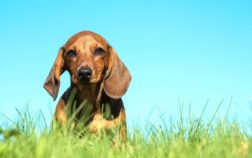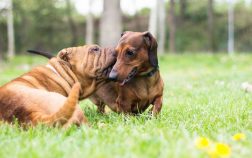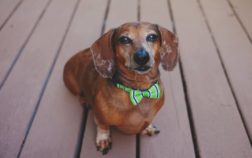Doxies are very popular but still often misunderstood dog breed. So, here are the main 6 dachshund facts and information tidbits you should know before getting a Doxie. We can’t possibly fit everything in a single short article but we’ll run through the basics to give you an idea of what you’re getting into.
What Are The 6 Main Dachshund Facts And Information Tidbits You Should Know?
1. Unique Body Type – Shorter Legs Not So Much Longer Backs
Dachshunds are often said to have “long backs”. And that’s true but only relative to the rest of their bodies. In reality, dachshunds have a grand total of 30 vertebrae on their spines – just as much as any other dog breed.
So, the dachshund’s back isn’t technically “longer” it just looks that way because their legs are extra short. The reason their legs are shorter is that these dogs were bred specifically to have dwarfism – a genetic anomaly that does have its drawbacks on the dog’s health but helps dachshunds be better hunters by allowing them to jump in their prey’s dens.

Unfortunately, the end result is the same as the dachshunds’ backs are too long for their legs to support correctly, hence the occasional back issues Doxies have.
2. Dachshunds Are The Quintessential Scent Hound – Dachshund Facts And Information
The idea that shorter legs make dogs better hunters sounds absurd and it would be for most other breeds. For the dachshund, however, that’s what makes them the best possible fox and badger hunting breed. In fact, the dachshund’s name translates as “badger hound” in German (dachs-hund). And, while dachshunds are rarely used for hunting in the US, European fox and badger hunters still value and use the breed quite regularly.
3. Doxies Come In Dozens Of Coat Types, Colors, Patterns, And Sizes
Dachshunds are available in about 20 recognizable coat color types, many more variations not all kennel clubs recognize, three coat types (short/smooth, long, and wiry), various coat color patterns, as well as 2 main size variants – standard and miniature. There are also the toy, teacup, and kaninchen (rabbit) dachshund size categories but those are usually not recognized by most kennel clubs as breeding such small dogs is not great for their health.
Royal Canin Dachshund Adult Breed Specific Dry Dog Food, 10 lb bag
For, as a future dachshund owner, however, all that means is that you have a great variety of dachshunds to choose from.
4. Willful And Stubborn When It Comes To Training – Dachshund Facts And Information
This is a trait shared by almost all scent hound and terrier breeds and isn’t unique to dachshunds. Simply put, unlike gun dogs, setters, pointers, and retrievers, scent hounds and terriers were bred to hunt by focusing solely on their target and ignoring all other stimuli around them. As such, they weren’t bred to follow orders or ignore their instincts – the opposite.
For you, as a Doxie owner, this means that a bit more obedience training and longer potty training will be necessary.
5. Affectionate And Loving But Can Still Use Good Socialization To Get Along With Strangers
Dachshunds are great family pets that have lots of love to give. They can get along with other people, dogs, and even non-canine pets but they’ll need quite a bit of socialization to do that. Especially if the other dog is larger than them – they can learn to love a larger animal, they’ll just need a bit more time.
6. Serious Risk Of Back Problems If You Don’t Care For Them Right
The biggest health concern for dachshunds is Intervertebral Disc Disease (IVDD). There is a hereditary component to it as some dogs are more susceptible than others but the lifestyle/care part is also huge. IVDD is why you should use a harness instead of a collar, why your dachshund should be forced to jump too high, why its food needs extra calcium, and so on.
Conclusion – Dachshund Facts And Information
All in all, dachshunds are great pets to have at home, they just need a bit of care, training, and socialization – pretty much like any other dog.
FAQ’s
[rank_math_rich_snippet id=”s-c87aed15-fcf9-4908-931c-0839e7accde6″]





